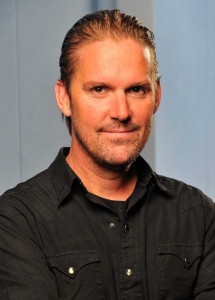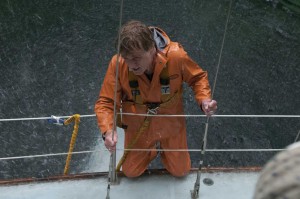
Our Man is alone aboard a 39-foot sailboat traversing the Indian Ocean, 28 million square miles of open sea, when his vessel is struck by a floating cargo container and begins taking on water. With no one else aboard and the radio inoperable because of the influx of seawater, there is truly no one to talk to, no opportunity to review the consequences of the collision with another person and no one to consult about a plan of action.
In this tale of a solitary struggle for survival, one might think that sound would be of little consequence, almost an afterthought. To the contrary, sound is the element that gives shape to the action and places us authentically in the boat with its skipper. Every action, from the initial collision to the gathering storm, is announced first through sound and only later with visuals.
Robert Redford, Our Man in the sailboat, relied upon Steve Boeddeker and his associate at Skywalker Sound, Richard Hymns, for the post-sound work on his picture The Company You Keep and was instrumental in affording their introduction with J.C. Chandor, director of All Is Lost. At their initial meeting, Boeddeker recalls that Chandor was so enthusiastic about the project “he was talking a million miles an hour.”
That enthusiasm was contagious and persuaded Skywalker to take on this small, low-budget picture and assign significant resources to the project. Boeddeker, both sound designer and supervising sound editor, shared sound editing chores with Hymns and Brandon Proctor. Informally, Boeddeker and Proctor decided to divide areas of focus, with Boeddeker concentrating on boat and ocean sounds and Proctor on Our Man.

While a production sound mixer had been assigned to the project, the film had been shot almost as a silent movie and the production tracks were largely unusable. This resulted when the production sound recordist was unable to get a microphone close enough to the actor, or because J.C. Chandor would actively give direction throughout the takes. Except for a few places, the sound had to be created from scratch in the editing suite, using the production tracks only as a guide.
Boats are a noisy environment. The hull is under strain from multiple directions as the water, the ballast and the sails all apply twisting forces and the rigging, mast and steel shrouds, pull in the other direction. There are constant creaks from the hull, the ting of shrouds and the noises of hatches and deck grating. Fortunately, Hymns, an experienced sailor, consulted with Boeddeker to keep the sound elements true to what one would hear in a sailboat.
Of course, this isn’t a documentary and concerns about perfect authenticity shouldn’t conflict with effective storytelling. For the scene where Our Man ascends the mast to repair the radio antenna connection, the sound team ordered an identical Bosun’s chair to record the winching in a Foley studio. To make the ratcheting effect hyper realistic, the sound team mixed in other elements, including winding an alarm clock. As he moves up the mast away from the deck, the familiar sounds of his normal environment diminish and he becomes further isolated. When he hears the ominous rumble of the approaching storm, the sound is magnified by his isolation.
The general approach to the sound was well mapped in Chandor’s script but the creative realization of the themes by Boeddeker and his associates enhanced the experience at every wind-shift.





